The FSSB Modification Kit
One of the biggest problems that appear while building a good F-16 cockpit is the Side Stick
Controller, also called the
SSC. On one side the SSC is a device
that requires very little space and uses a technique that is not available at any usual joystick,
but let's talk about it part by part.
| The technic of the real SSC |
 |
The SSC is located at the real F-16 at the
Right Aux. Console. This
SSC has features that make it different from almost all other plane's flight controls. At the SSC
the flight commands are not given by a movement of the stick, but by the applied force on the stick.
The bigger the applied force in a certain direction is applied, the bigger the movement of the
control surfaces, which take the plane into the desired position. This feature gives the F-16 a very
special control feeling. I had the chance to fly a "real" US Air Force simulator and I can assure
that it is a very special feeling in deed. At the beginning it is difficult to get used to the fact,
that you are "telling" a rigid stick, where you want to go to, but after a while you get used to it
(it happens faster than you think). Once you have reached this point, you will be able to perform a
very precise handling of the F-16. It is very fond to fly using this technique and I was always
missing this feeling on my own joystick.
Inside the SSC there are Force Transducers. These transducers modify their electric resistance
depending on the amount of the applied force. Thanks to this technique the SSC requires only very
little space, as no large movements are required. And exactly this required narrow space can drive a
cockpit builder into madness. A normal joystick cannot be installed properly into the Right Aux.
Console, as the available space is too small. Therefore you would have to position your stick
farther to the outside, but the panels that are placed there do not allow this either. The only
thing to do would be to move those panels also farther to the right, and there is no available place
to do this :-(
|
The original SSC in the cockpit
|
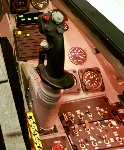
You see...
|
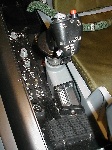
...it's not enough...
|
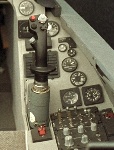
...space here
|
| The FSSB modification kit |
 |
The Spanish company called
Realsimulator
has cognized this problem also and has developed a modification kit called FSSB for the
Thrustmaster's Cougar. Cougar should be well
known to almost all of the cockpit builders, as it is the best replica of the F-16's HOTAS that is
available. This replica is now enhanced by the FSSB from Realsimulator. As I already have some
devices from Realsimulator (
Rudder pedals, ICP among others) and
the quality of these devises is very good, I did not miss the chance to get the FSSB as soon as it
was available.
After some days I received a little box containing the FSSB parts. The modification kit basically is
formed by three components:
- A cylinder that hosts the Force Transducer, which will be fixed to the Cougar's grip.
- An electronic circuit that is mounted at the rear side of the housing
- A metallic plate to cover the top of the housing
All required nuts and screws are also delivered in the kit. As I felt a little lazy at that time, I
did not read the included guide, as I wanted to see, if a normal guy like me would be able to
perform this modification (Learn by doing):
|
The modification kit
|

That was inside
|
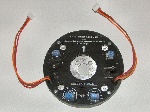
The electronic circuit
|
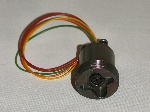
The Force Transducer
|
| The installation of the FSSB |
 |
Once you have loosened the Cougars grip, you have to loosen all screws, and I really do mean all
screws, even the hexagonal nuts that hold the connectors for the RCS and the TQS. This loosening
turned out to be the most difficult part, as one screw was protected by a coating that made it
difficult to unscrew it. Only after applying some force, the screw was loosened and could be taken
out. Once I had done this, the mounting of the FSSB could start.
First I had to mount the electronic plate using four screws. This plate is holding the Dip switches
that allow selecting the desired force. This selection can be done for each axis (x and y)
separately. The default selects a force of 6 Lbs and can be adjusted up to 21 Lbs. I would recommend
to use the 6 Lbs, as it is the best to be used with the original Cougar's housing. Of course this is
not the real force used in the real F-16, as if you would use it, the Cougar's housing would be
pushed all around your desk when applying the force to it, unless it is fixed to the desk by screws
or any other fixing device. The real force values should be used in combination with the real base,
which has to be a solid part of the cockpit. I want to point out, that if you have a wooden cockpit,
you should not use the 21 Lbs force selection, as you will break the wood while applying the force
to the stick ;-)
Back to the modification works: when you mount the round electronic plate, you have to make sure it
fits into the correct position. This is achieved, by aligning the printed arrow with the "forward"
direction.
The cylinder hosting the force transducers comes next. You have to introduce it into the housing
from the top and mount it using also four screws. Also here you have to make sure, that the right
alignment is kep. Otherwise flying might become a real adventure later on ;-) In order to avoid any
surprise, I would recommend testing the stick before the final mounting.
Once you have finished these prior steps, three cables will be hanging out of the housing. These
cables have to be connected to the original Cougar-plate, using the corresponding plugs and
connectors. The chance to make any mistake at this step is very small. The only mistake could be to
swap the cables going to the x- and to the y-axis. The left cable has to be connected to the left
part of the Cougar plate and the right cable to the right side.
After this I mounted the cover plate using eight screws. Perhaps this would have been easier, if I
had installed the plate first.
Finally you have to mount the original Cougar plate onto its corresponding place (don't forget the
hexagonal screws of the connectors) Now you can mount the bottom of the Cougar. That's all. The
complete modification took about 20 minutes ;-)
|
The installation
|
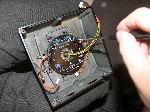
Mounting the elec. circuit
|
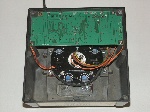
The finish FSSB
|
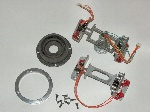
The rest of the Cougar
|
| The test of the FSSB |
 |
After all the modification work was done, I was really curious if it would work as I imagined. Would
it feel as the "real" stick? Are the axis x and y correct? It would be funny if instead of climbing
I would perform a roll. I selected the joystick at Windows and I was really happy to see that it was
recognized and reacted in the correct manner. Then (some nervous) I started Falcon and went right
into a training TE. WOW! What a great feeling!!!! I feel like being beamed 4 years into the past,
when I flew the "real" simulator. It was the just the same. After a very short time I get used to
this feeling again and after some flight patterns I fly my first approach for landing. The F-16
reacts perfectly. No swapping or jumping and you can perform precise adjustments in your flight. The
zero position is perfectly centered and the centering works perfectly. The only problem I found, was
that after some time flying, my hand was starting to sore, but this is not originated by the FSSB
itself, but by the unergonometric position of the stick. This correct position can only be achieved
in a cockpit, where your hand and your forearm form a straight line. When flying on a desk, this
position of course is not reached.
After several hours of flying, I would not like to miss the FSSB any longer. It works perfectly. Of
course you have to get used to it first, as there is no longer visual reference of the movement the
stick is doing. You will realize this especially during Dog Fighting, as you will probably have the
tendency to perform more movement as required. Therefore: at the beginning, to get used to it, it is
better to pull a little less that too much. You will also notice, that you will get tired, as you
now are applying force (perhaps you should visit a fitness-studio first :-) You will need some
practice, but after a while you will be able to handle it. And in a real cockpit you haven't a voice
that say to you: "You can pull - pull - more pull - and Stop!" ;-)
As usual, I have some very small critic to make at this time (yes yes, I am horrible ;-). The real
sensors of the F-16 are rotated aprox. 12.5 degrees clockwise, to assure a proper ergonomically position of
the hand. It has always disturbed me that this isn't copied exactly in the Cougar. Unfortunately,
the FSSB doesn't repair this small fault. Of course you can rotate the complete base by this angle, but I
am a perfectionist ;-)
One other positive aspect of the Modification-Kit is the fact that no original part of the Cougar
has to be modified or destroyed. Therefore you can keep all the original parts, making it possible
to re-install them into the Cougar if you have a guarantee problem some later on.
Finally I can only say - PERFECT!!!! I am really happy that the FSSB gives me the real feeling of
flying a F-16 and that I have approached the real thing one further step.
| Pictures from the FSSB |
 |
|
The FSSB modification kit
|
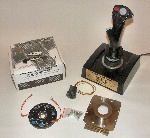
The beginning
|
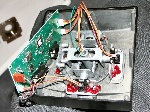
The original Cougar...
|
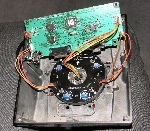
...and the FSSB
|
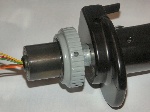
Force-Transducer on stick
|
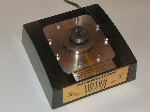
The case
|
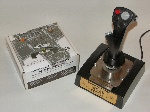
All finish
|
Note:
To zoom please select the picture with your mouse.





















